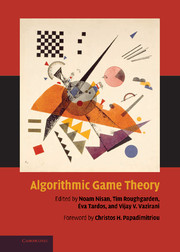Foreword
Published online by Cambridge University Press: 31 January 2011
Summary
As the Second World War was coming to its end, John von Neumann, arguably the foremost mathematician of that time, was busy initiating two intellectual currents that would shape the rest of the twentieth century: game theory and algorithms. In 1944 (16 years after the minmax theorem) he published, with Oscar Morgenstern, his Games and Economic Behavior, thus founding not only game theory but also utility theory and microeconomics. Two years later he wrote his draft report on the EDVAC, inaugurating the era of the digital computer and its software and its algorithms. Von Neumann wrote in 1952 the first paper in which a polynomial algorithm was hailed as a meaningful advance. And, he was the recipient, shortly before his early death four years later, of Gödel's letter in which the P vs. NP question was first discussed.
Could von Neumann have anticipated that his twin creations would converge half a century later? He was certainly far ahead of his contemporaries in his conception of computation as something dynamic, ubiquitous, and enmeshed in society, almost organic – witness his self-reproducing automata, his fault-tolerant network design, and his prediction that computing technology will advance in lock-step with the economy (for which he had already postulated exponential growth in his 1937 Vienna Colloquium paper).
- Type
- Chapter
- Information
- Algorithmic Game Theory , pp. xiii - xviPublisher: Cambridge University PressPrint publication year: 2007



